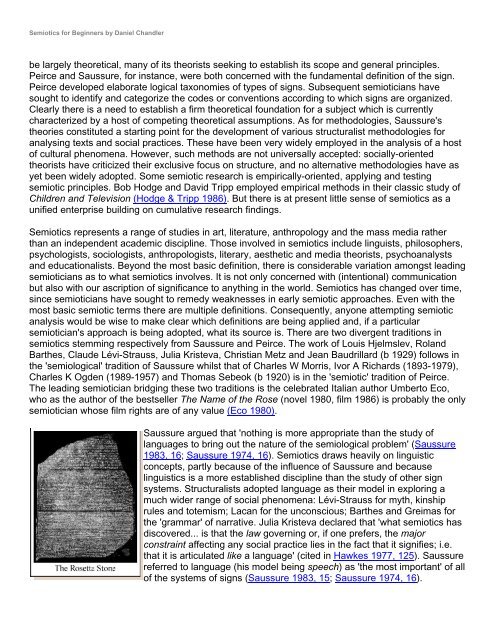Semiotics for Beginners by Daniel Chandler
Semiotics for Beginners by Daniel Chandler
Semiotics for Beginners by Daniel Chandler
You also want an ePaper? Increase the reach of your titles
YUMPU automatically turns print PDFs into web optimized ePapers that Google loves.
<strong>Semiotics</strong> <strong>for</strong> <strong>Beginners</strong> <strong>by</strong> <strong>Daniel</strong> <strong>Chandler</strong><br />
be largely theoretical, many of its theorists seeking to establish its scope and general principles.<br />
Peirce and Saussure, <strong>for</strong> instance, were both concerned with the fundamental definition of the sign.<br />
Peirce developed elaborate logical taxonomies of types of signs. Subsequent semioticians have<br />
sought to identify and categorize the codes or conventions according to which signs are organized.<br />
Clearly there is a need to establish a firm theoretical foundation <strong>for</strong> a subject which is currently<br />
characterized <strong>by</strong> a host of competing theoretical assumptions. As <strong>for</strong> methodologies, Saussure's<br />
theories constituted a starting point <strong>for</strong> the development of various structuralist methodologies <strong>for</strong><br />
analysing texts and social practices. These have been very widely employed in the analysis of a host<br />
of cultural phenomena. However, such methods are not universally accepted: socially-oriented<br />
theorists have criticized their exclusive focus on structure, and no alternative methodologies have as<br />
yet been widely adopted. Some semiotic research is empirically-oriented, applying and testing<br />
semiotic principles. Bob Hodge and David Tripp employed empirical methods in their classic study of<br />
Children and Television (Hodge & Tripp 1986). But there is at present little sense of semiotics as a<br />
unified enterprise building on cumulative research findings.<br />
<strong>Semiotics</strong> represents a range of studies in art, literature, anthropology and the mass media rather<br />
than an independent academic discipline. Those involved in semiotics include linguists, philosophers,<br />
psychologists, sociologists, anthropologists, literary, aesthetic and media theorists, psychoanalysts<br />
and educationalists. Beyond the most basic definition, there is considerable variation amongst leading<br />
semioticians as to what semiotics involves. It is not only concerned with (intentional) communication<br />
but also with our ascription of significance to anything in the world. <strong>Semiotics</strong> has changed over time,<br />
since semioticians have sought to remedy weaknesses in early semiotic approaches. Even with the<br />
most basic semiotic terms there are multiple definitions. Consequently, anyone attempting semiotic<br />
analysis would be wise to make clear which definitions are being applied and, if a particular<br />
semiotician's approach is being adopted, what its source is. There are two divergent traditions in<br />
semiotics stemming respectively from Saussure and Peirce. The work of Louis Hjelmslev, Roland<br />
Barthes, Claude Lévi-Strauss, Julia Kristeva, Christian Metz and Jean Baudrillard (b 1929) follows in<br />
the 'semiological' tradition of Saussure whilst that of Charles W Morris, Ivor A Richards (1893-1979),<br />
Charles K Ogden (1989-1957) and Thomas Sebeok (b 1920) is in the 'semiotic' tradition of Peirce.<br />
The leading semiotician bridging these two traditions is the celebrated Italian author Umberto Eco,<br />
who as the author of the bestseller The Name of the Rose (novel 1980, film 1986) is probably the only<br />
semiotician whose film rights are of any value (Eco 1980).<br />
Saussure argued that 'nothing is more appropriate than the study of<br />
languages to bring out the nature of the semiological problem' (Saussure<br />
1983, 16; Saussure 1974, 16). <strong>Semiotics</strong> draws heavily on linguistic<br />
concepts, partly because of the influence of Saussure and because<br />
linguistics is a more established discipline than the study of other sign<br />
systems. Structuralists adopted language as their model in exploring a<br />
much wider range of social phenomena: Lévi-Strauss <strong>for</strong> myth, kinship<br />
rules and totemism; Lacan <strong>for</strong> the unconscious; Barthes and Greimas <strong>for</strong><br />
the 'grammar' of narrative. Julia Kristeva declared that 'what semiotics has<br />
discovered... is that the law governing or, if one prefers, the major<br />
constraint affecting any social practice lies in the fact that it signifies; i.e.<br />
that it is articulated like a language' (cited in Hawkes 1977, 125). Saussure<br />
referred to language (his model being speech) as 'the most important' of all<br />
of the systems of signs (Saussure 1983, 15; Saussure 1974, 16).




